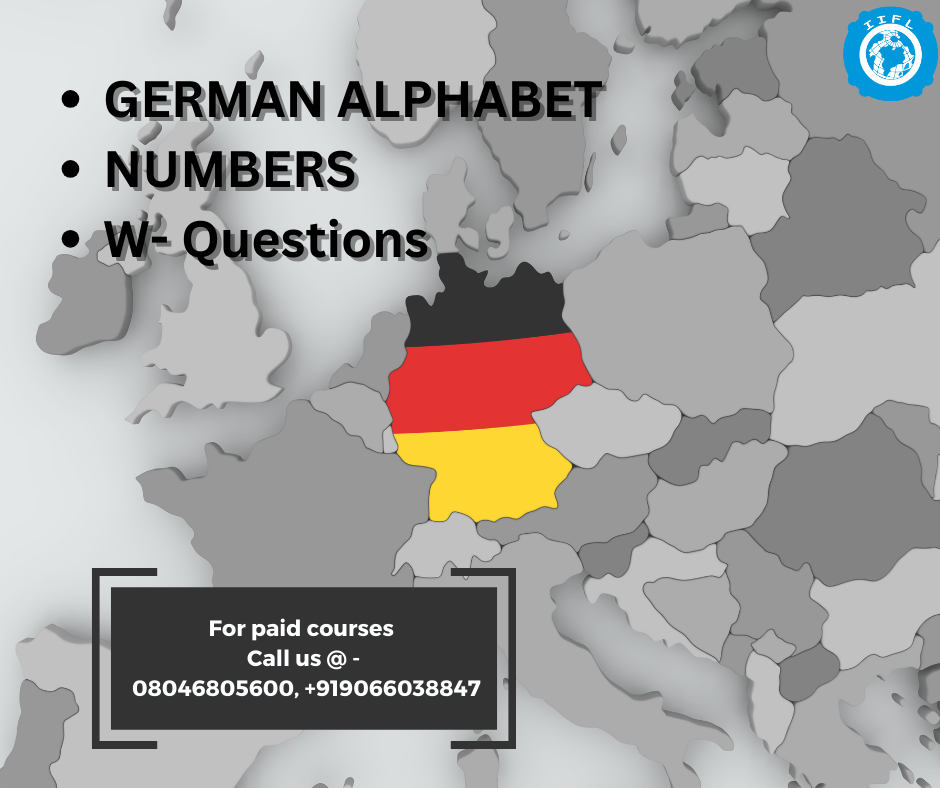German alphabet, numbers and W- Questions
German for beginners | German alphabet | numbers | Introduction | w- questions | Months | seasons |
German for beginners:- Topics included
- Alphabet – German has 26 letters, 1 special character, 3 vowels
- Numbers – ZAHLEN, learn saying numbers in German!
- Basic introduction – Die vorstellung. Learn the greetings in German.
- W- questions – Questions starting with W
- Names of Months – Die Monaten, Months in German are quite similar to English
- Names of seasons – Die Jahreszeiten
For more German beginner courses follow our updates
Call us for a FREE DEMO class of German courses: – 080 46805600 +91 9066038847
German ALphabet
The German alphabet, known as the “deutsche Alphabet” or “das Alphabet,” is based on the Latin script and consists of 26 letters, just like the English alphabet. However, there are four additional letters in the German alphabet, known as “Umlauts,” which are modified versions of standard vowels. Here is the German alphabet:
- A – pronounced like the “a” in “father”
- B – pronounced like the “b” in “book”
- C – pronounced like the “ts” in “tsunami” (mainly used in loanwords)
- D – pronounced like the “d” in “dog”
- E – pronounced like the “e” in “pen”
- F – pronounced like the “f” in “fish”
- G – pronounced like the “g” in “go”
- H – pronounced like the “h” in “house”
- I – pronounced like the “ee” in “see”
- J – pronounced like the “y” in “yes”
- K – pronounced like the “k” in “kite”
- L – pronounced like the “l” in “lake”
- M – pronounced like the “m” in “moon”
- N – pronounced like the “n” in “noon”
- O – pronounced like the “o” in “go”
- P – pronounced like the “p” in “pen”
- Q – pronounced like the “k” in “kite” (mainly used in loanwords)
- R – pronounced with a guttural “r” sound
- S – pronounced like the “s” in “see”
- T – pronounced like the “t” in “top”
- U – pronounced like the “oo” in “food”
- V – pronounced like the “f” in “fish” (or like “v” in some loanwords)
- W – pronounced like the “v” in “vase” (or like “w” in some loanwords)
- X – pronounced like “ks” or “gs” (mainly used in loanwords)
- Y – pronounced like the “ü” in “über” (mainly used in loanwords)
- Z – pronounced like the “ts” in “tsunami”
In addition to the standard 26 letters, German includes the following Umlaut characters:
- Ä – pronounced like the “a” in “cat,” but with lips rounded
- Ö – pronounced like the “i” in “bird,” but with lips rounded
- Ü – pronounced like the “u” in “blue,” but with lips rounded
- ß – called “Eszett” or “scharfes S,” it is a unique German letter that represents the “ss” sound, as in “sharp.”
These Umlaut characters are modifications of standard vowels and are used to indicate a different pronunciation in German words.
Click here to learn more about German Online Language Courses
Learning the German alphabet is a fundamental step in mastering the language, as it forms the basis for spelling, pronunciation, and reading.
A detailed guide for German teachers

German Numbers
Here are the numbers from 1 to 10 in German:
- Eins – One
- Zwei – Two
- Drei – Three
- Vier – Four
- Fünf – Five
- Sechs – Six
- Sieben – Seven
- Acht – Eight
- Neun – Nine
- Zehn – Ten
And here are the numbers from 11 to 20:
- Elf – Eleven
- Zwölf – Twelve
- Dreizehn – Thirteen
- Vierzehn – Fourteen
- Fünfzehn – Fifteen
- Sechzehn – Sixteen
- Siebzehn – Seventeen
- Achtzehn – Eighteen
- Neunzehn – Nineteen
- Zwanzig – Twenty
To form higher numbers in German, you follow a straightforward pattern. For example:
- 21: Einundzwanzig (One and twenty)
- 32: Zweiunddreißig (Two and thirty)
- 45: Fünfundvierzig (Five and forty)
The “and” in these numbers is represented by “und.”
Click here to learn more about German vocabulary
Here are some more numbers for reference:
30: Dreißig – Thirty 40: Vierzig – Forty 50: Fünfzig – Fifty 60: Sechzig – Sixty 70: Siebzig – Seventy 80: Achtzig – Eighty 90: Neunzig – Ninety 100: Hundert – Hundred 1,000: Tausend – Thousand
To create larger numbers, you can simply combine these elements. For example, 153 would be Hundertdreiundfünfzig (One hundred three and fifty).
Remember to pay attention to the gender of nouns and apply appropriate article endings when using numbers in German. Learning numbers is essential for everyday communication, from discussing prices and quantities to telling time and giving dates.
Learn more about German Corporate Training in India




